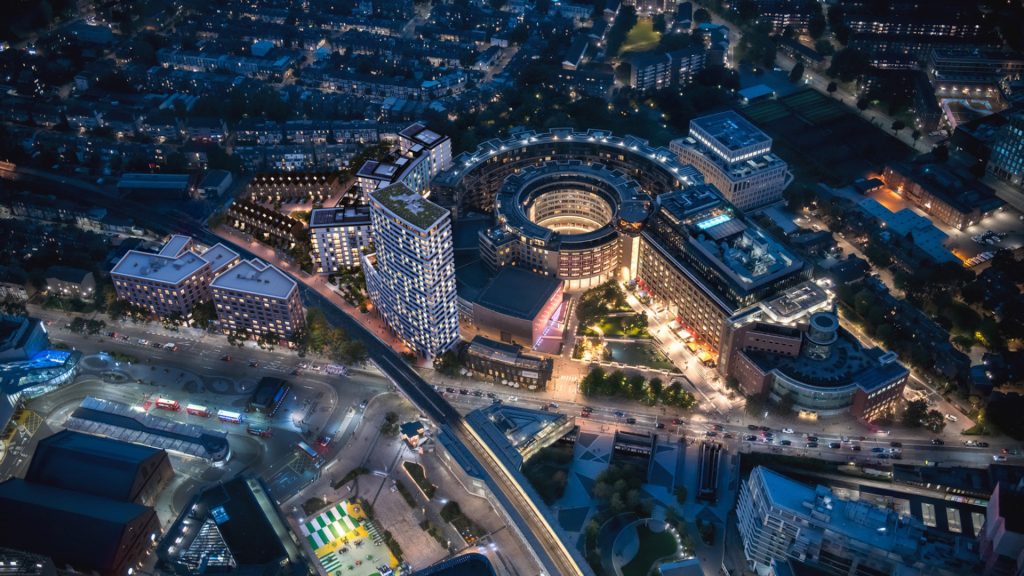Breathing new life into a cultural icon with technology
One of London’s most iconic landmarks, the former BBC Television Centre, is a cornerstone of British history. After over 50 years of service, the centre underwent significant redevelopment to breathe new life into this much-loved part of the city’s skyline. In 2013, the site was transformed into a mixed-use destination, combining luxury residences, creative workspaces and premium amenities.
However, reimagining a complex once celebrated as the “cathedral of entertainment and news” presented a major challenge – preserving its cultural heritage while adapting the space for modern living.
The challenge: selling the vision before construction
The Boundary, a global creative agency specialising in the best-in-class photorealistic visuals and immersive experiences for products, architecture and the built environment, was selected to bring the redevelopment to life. The Boundary dedicated its focus on the new residential building in the complex, The Ariel – a residence yet to be built.
The team crafted photorealistic marketing visuals that honoured the site as a cultural landmark, whilst also creating a visual experience that could be imagined as a home for future residents. The Boundary’s deliverables included CGIs, animations, a marketing film, and interactive real-time tours.
The Ariel project demanded a visual narrative that would help prospective buyers and tenants imagine life within the space. Materials needed to capture atmosphere, from how light shifts throughout the day, to how textures feel, and how people move throughout the space. Bringing that level of realism to life – with both accuracy and emotion – required the right technology.
Transforming visuals with Chaos Corona
Redefining design workflows with up to 80% time savings
The Boundary relied on Chaos Corona, an easy to use rendering software for architectural visualisation, for all rendered content. The tool’s flexibility meant they could create photorealistic images and easily tweak them based on feedback, without having to start from scratch each time a change was requested by the developer. This made the design process faster and more collaborative, saving time and money for the wider project with fewer iterations being produced.
The interiors at The Television Centre showcased a complex ceiling design that went through numerous iterations. What would typically require skilled modellers several hours to model and implement changes at each design development stage was streamlined to a fraction of the time using Corona’s Slicer tool.
By leveraging the tool’s ability to modify geometry with remarkable precision, the team significantly decreased the time spent on remodelling while ensuring accuracy. They could swiftly implement the design changes while ensuring the ceiling’s intricate details aligned with aesthetic and functional requirements.
Used with the Slicer, the Corona Pattern tool simplified the mapping of the ceiling’s intricate details and complex panelling. When designs changed multiple times, the team could adapt without compromising quality or project timelines.
The Boundary estimates that Corona tools saved up to 80% of the usual time spent to generate a render as intricate as this one, without compromising quality. In turn, the ability to rapidly test and refine designs significantly lowered expenses related to mistakes and delays.
Making space for creativity
At the heart of any project lies creativity. The Boundary relied on Corona Sun and Sky were used to create initial clay compositions, offering greater flexibility and the ability to test solutions using a range of tools. Sun direction and size were changed to quickly output lighting tests from morning to night, from sharp sun to overcast. With Volume Effect, the team could create depth that would otherwise require costly volumetrics. Designs, textures and materials were trialled and refined with technology that gave the team creative licence, without the risk of costly mistakes.
When vision meets technology through partnership
Today, what was once home to the BBC is now set to be home to approximately 950 residents, enjoying a reimagined creative district with a host of new amenities. The revival of an icon was never an easy project to conceptualise, but through emotive visuals, the end goal became easier to picture. The success of the redevelopment hinges not just on technology, but on the creative teams who utilised it to its full potential.
For Chaos, each of our customers are viewed as creative partners. Projects like this exemplify that collaboration, giving us the chance to see the tangible impact of our tools while building strong, lasting relationships with the people who use them. Meanwhile, our customers can rely on technology that they can trust.
“I have been using Corona since the very initial release and never looked back. It is one of the most utilised and trusted software we use in our studio.”
Eleonora Galimberti, Senior Associate at The Boundary
This redevelopment is a testament to what happens when creative vision meets trusted technology, transforming not just spaces but the way we experience them.
Visit www.chaos.com to learn more.








